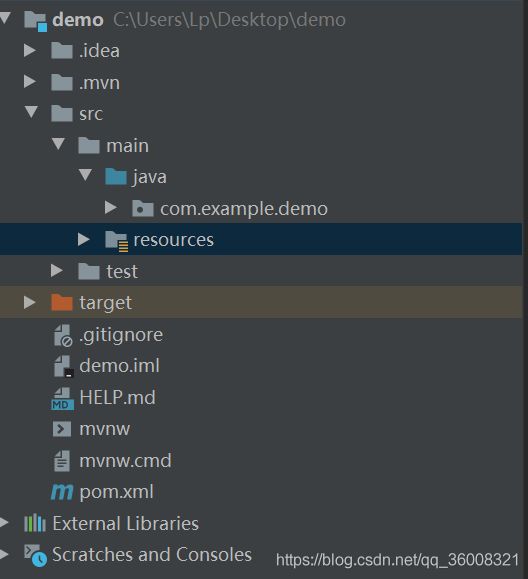SpringBoot整合mybatis基础配置Demo
前言:
Spring-boot的入门配置,节约了大量配置的过程,使配置流程变的非常简洁。
- Spring-boot 基于Idea 2019.2.4环境搭建
- MyBatis 整合
- 简单增删改查接口测试
第一步,创建Spring-boot项目
本文基于idea提供的模板创建Spring-boot项目,。而且Spring-boot内置了Tomcat,也不需要配置Spring那一套,所以特别的方便简洁,特别适合用来建立微站。
创建的步骤:
(1)打开idea -> 选择菜单File -> New -> Project,打开项目创建面板,选择Spring Initializr。

(2)点击Next,进入Project Metadata面板,填写Group、Artifact、Package等信息。基本上都会给默认配置,除了个别的遵从默认配置就好。

(3) 再次点击Next,进入Dependencies选择面板,选择我们所需要的包,首先Web -> 选择Spring Web ,SQL -> 选择 JDBC API ,MYSQL Drivar , Mybatis Framework。

(3)接着点击Next,进入最后一个面板,填写Project name,Project Location等相关信息,直接Finish。

(4)等待idea加载模板,等进度条全部加载完毕,说明我们的项目也创建完毕。文件结构如下:

(5)测试我们的项目,在DemoApplication中增加一个@RestController注解,这个注解的意思是@Controller和@RequestBody的结合,意义如下:
- @Controller 将当前修饰的类注入SpringBoot IOC容器,使得从该类所在的项目跑起来的过程中,这个类就被实例化。当然也有语义化的作用,即代表该类是充当Controller的作用
- @ResponseBody 它的作用简短截说就是指该类中所有的API接口返回的数据,甭管你对应的方法返回Map或是其他Object,它会以Json字符串的形式返回给客户端,本人尝试了一下,如果返回的是String类型,则仍然是String。
- @SpringBootApplication相当于@SpringBootConfiguration、@EnableAutoConfiguration和@ComponentScan三个注解合在器的作用,目的是开启自动配置。

点击运行,输入http://localhost:8080/出现如下页面,代表项目创建成功:

第二步,整合Mabits框架
MyBatis是一款优秀的持久层框架,它支持定制化 SQL、存储过程以及高级映射。MyBatis 避免了几乎所有的 JDBC 代码和手动设置参数以及获取结果集。MyBatis 可以使用简单的 XML 或注解来配置和映射原生类型、接口和 Java 的 POJO(Plain Old Java Objects,普通老式 Java 对象)为数据库中的记录。简单的说MyBatis就是类似Hibernate的ORM框架,相比之下要轻便、灵活的多,更易保证DB访问的性能。
(1)首先,在pom.xml中添加Matits所需要的dependency,idea会自动去网上集成相应的jar包。
<dependency>
<groupId>org.mybatis.spring.bootgroupId>
<artifactId>mybatis-spring-boot-starterartifactId>
<version>2.1.1version>
dependency>
<dependency>
<groupId>com.alibabagroupId>
<artifactId>druidartifactId>
<version>1.1.0version>
dependency>
<dependency>
<groupId>mysqlgroupId>
<artifactId>mysql-connector-javaartifactId>
<scope>runtimescope>
dependency>
(2)之后,填写application.yml文件的相关配置项,设置数据库相关的配置以及Mabits配置信息,配置文件如下:
#访问端口号
server:
port: 8080
#编码格式
tomcat.uri-encoding: utf-8
servlet:
session:
timeout: 30m
#数据库相关配置
spring:
datasource:
driver-class-name: com.mysql.cj.jdbc.Driver
url: jdbc:mysql://localhost:3306/test?characterEncoding=utf8&serverTimezone=GMT
username: root
password: root
type: com.alibaba.druid.pool.DruidDataSource
#应用名称
application:
name: demo
http:
encoding:
charset: UTF-8
force: true
jackson:
default-property-inclusion: non_null
mybatis:
mapper-locations: classpath:mapper/*Mapper.xml
type-aliases-package: com.example.demo.entity.entity
(3)接下来,创建一个entity.User实体类,用来映射我们存储到数据库中的结构化数据信息;再创建mapper.UserMapper接口类,存储对应接口;以及service.UserService类;最后在resources下创建一个mapper/UserMapper.xml文件,具体代码如下:
entity.User
package com.example.demo.entity;
public class User {
private int id;
private String username;
private String password;
public int getId() {
return id;
}
public void setId(int id) {
this.id = id;
}
public String getUsername() {
return username;
}
public void setUsername(String username) {
this.username = username;
}
public String getPassword() {
return password;
}
public void setPassword(String password) {
this.password = password;
}
}
mapper.UserMapper
package com.example.demo.mapper;
import com.example.demo.entity.User;
import org.apache.ibatis.annotations.ResultMap;
import org.apache.ibatis.annotations.ResultType;
import org.apache.ibatis.annotations.Select;
import java.util.List;
public interface UserMapper {
Integer insertUser(User user);
Integer batchInsertUser(List<User> users);
User deleteUser(Integer id);
User updateUser(User user);
User selectUser(Integer id);
List<User> selectAllUser();
}
service.UserService
package com.example.demo.service;
import com.example.demo.entity.User;
import com.example.demo.mapper.UserMapper;
import org.springframework.stereotype.Service;
import javax.annotation.Resource;
import java.util.List;
@Service
public class UserService {
@Resource
private UserMapper userMapper;
public Integer insertUser(User user) {
return userMapper.insertUser(user);
}
public Integer insertUser(List<User> users) {
return userMapper.batchInsertUser(users);
}
public User deleteUser(Integer id) {
return userMapper.deleteUser(id);
}
public User updateUser(User user) {
return userMapper.updateUser(user);
}
public User selectUser(Integer id) {
return userMapper.selectUser(id);
}
public List<User> selectUser() {
return userMapper.selectAllUser();
}
}
mapper.UserMapper.xml
<?xml version="1.0" encoding="UTF-8" ?>
<!DOCTYPE mapper PUBLIC "-//mybatis.org//DTD Mapper 3.0//EN" "http://mybatis.org/dtd/mybatis-3-mapper.dtd" >
<mapper namespace="com.example.demo.mapper.UserMapper">
<resultMap id="userMap" type="com.example.demo.entity.User">
<id column="id" property="id" jdbcType="INTEGER"/>
<result column="username" property="username" jdbcType="VARCHAR" />
<result column="password" property="password" jdbcType="VARCHAR" />
</resultMap>
<insert id="insertUser" useGeneratedKeys="true" keyProperty="id" parameterType="com.example.demo.entity.User">
insert into t_user (username, password)
values(#{username,jdbcType=VARCHAR}, #{password,jdbcType=VARCHAR})
</insert>
<insert id="batchInsertUser" useGeneratedKeys="true" keyProperty="id">
insert into t_user (username, password) values
<foreach item="item" collection="list" separator=",">
(#{item.username}, #{item.password})
</foreach>
</insert>
<delete id="deleteUser" parameterType="java.lang.Integer">
delete from t_user
where id = #id
</delete>
<update id="updateUser" parameterType="com.example.demo.entity.User">
update t_user
set username = #{username, jdbcType=VARCHAR}, password = #{password, jdbcType=VARCHAR}
</update>
<select id="selectUser" parameterType="java.lang.Integer" resultMap="userMap">
select * from t_user
where id = #{id,jdbcType=INTEGER}
</select>
<select id="selectAllUser" resultMap="userMap">
select * from t_user
</select>
</mapper>
(4) 最后,创建一个Controller,在Controller中,添加register和findAllUser接口,用来测试我们的项目对数据库的连接。代码如下:
package com.example.demo.web;
import com.example.demo.entity.User;
import com.example.demo.service.UserService;
import org.springframework.beans.factory.annotation.Autowired;
import org.springframework.web.bind.annotation.RequestMapping;
import org.springframework.web.bind.annotation.RequestMethod;
import org.springframework.web.bind.annotation.RestController;
import javax.servlet.http.HttpServletRequest;
import java.util.List;
@RestController
@RequestMapping("/user")
public class UserController {
@Autowired
private UserService userService;
@RequestMapping(value = "/register", method = RequestMethod.POST)
public String register (HttpServletRequest request) {
try {
String userName = request.getParameter("username");
String password = request.getParameter("password");
User user = new User();
user.setUsername(userName);
user.setPassword(password);
return userService.insertUser(user)+"";
} catch (Exception e) {
return e.getMessage();
}
}
@RequestMapping("/findAllUser")
public List<User> findAllUser() {
return userService.selectUser();
}
}
(5) 点击,运行,调用idea集成的REST Client接口测试工具(打开方式:菜单栏 > tools > HTTP Client > Test RESTfull Web Service),对两个接口进行测试,首先给注册接口添加username=aaa和password=111两个参数,然后点击运行。最后访问 findAllUser 接口,查看response返回,调用POST访问方式。

代码以分享到本人Github仓库